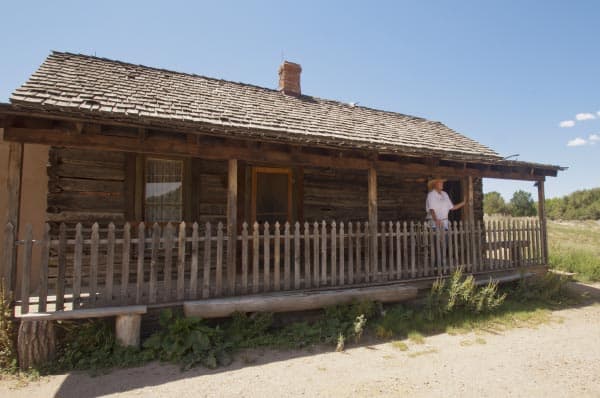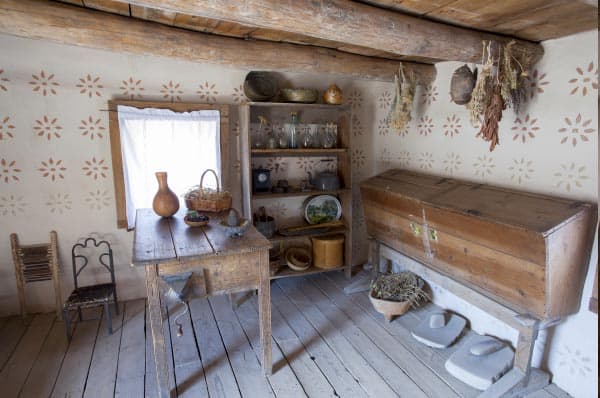
Country Store
This building from Las Trampas, NM was acquired from Mr. Jose Martinez of Vallecito, NM in 1969. At one point in the early 1900s it was a store/post office (a common feature in rural New Mexico) run by Jose Medina. He sold the store to two brothers, Jose C. Romero and Benito Romero. In 1908 Benito sold his share to Jose and moved to Vadito where he opened his own store/post office in 1916. He died in 1938 but his family ran the store for at least 40 more years. Jose continued to operate the store in Las Trampas until 1940. Mr. Paloheimo bought 3 counters and a glass display box from Romero that he had used in his store. Jose died in August 1968 and Mr. Paloheimo took up correspondence with his son and daughter and bought more items for the museum, including a couple of barns and some old doors.
As with many of the other buildings brought in from around the state, all the logs are marked with round metal numbers so that when they were brought to Las Golondrinas workers could reassemble the buildings exactly as they were originally built.
The sheep barn in the Baca Placita was also bought from Jose Romero. The barn was located behind his store in Las Trampas.
Leatherworking Shop
In the early 1970s Mr. Paloheimo had considered contracting Elias Sena to build a tannery at the ranch. Sena quit working at the ranch in early 1972 and the plans fell through. In 2000 the current hide tanning exhibit was built here at the museum.
Wheelwright Shop
The building that houses the Wheelwright Shop was originally a mill located just outside of Truchas. It was bought from Mrs. Bonifacio Dominguez in 1969. The equipment inside belonged to Miguel Casias, a third generation blacksmith.
Woodworkers/Carpenters Shop
Constructed in 2007 using new lumber and logs from an older building from the museum.
Talpa Mill
Built in the early 1800s, this mill is from Talpa, NM.
Old Golondrinas Mill
Purchased in the late 1960s from the Padilla Family of Truchas, NM. Rebuilt on site of original mill, which is mentioned in old wills.
Truchas Mill
Built by Jose de la Luz Barela in 1873 this mill was used until 1940. It was purchased in 1968 by the Paloheimos from members of the Barela family. In 1991 the mill was completely restored to working condition. There are only about ten Spanish Colonial style, horizontal water wheel powered grist mills left standing in the United States, three of them are at Las Golondrinas. The only one that is still operational is the Truchas Mill.
Blacksmith Shop
This building was originally a part of a small semi-ruined barn from a small village called El Guique, near San Juan Pueblo. It was bought from Max Martinez. The contents of the shop where bought from Manuel Apodaca in 1971. Apodaca was born in 1893 in Santa Fe and started working as a blacksmith helper at the age of 15. After serving in World War I he worked on Upper Canyon Road from 1928–1974. He died in 1977 at age 84.
Schoolhouse
There is conflicting research on the exact dates but the school house was built sometime around 1878 in Raton, NM as a private home. Tuition fees were paid by the parents because there were no public funds. Two years later the public school was built and the Raton Schoolhouse was abandoned. “It was later occupied as a residence by Mr. Leopold Biddle, a promoter and mining man of Elizabeth Town, with his daughter and son in law, Harvey Applegate. At this time additions were built to the house and it has ever since been used as a residence and is now the property of Mrs. Ida Atwater.” (1934 letter) It was donated to the ranch by Delores Noel of Tesuque in memory of her mother Ida Atwater. It was rebuilt at the ranch in 1980.
Morada
This Morada is a 2/3s replica of the south morada in Abiquiu, NM. It was built in 1972 by Elias Sena, the ranch foreman. 2,640 adobe bricks at 25¢ each were brought in to make the Morada. Sena was paid $6,900 for the work. Fourteen Penitente Hermanos from Arroyo Seco were present at the dedication of the morada at Fall Festival 1973. It is dedicated to Our Lady of Peace, La Conquistadora.
The crosses from the cemetery where collected by the State Department when they where building roads in northern New Mexico. No humans are interred at the site, however, Kitty Grey, a ranch cat is buried there.
Madrid House
Built in 1978 by 20th Century Fox for the filming of the movie Butch Cassidy and the Sundance Kid: The Early Years.
Shepherds Cabin
Donated by Betty Caldwell in 1984. This building was originally built in Colorado and Betty’s father, Jimmy Caldwell moved it to downtown Santa Fe in the 1950s. It was located behind 131–135 E. DeVargas St. by the river.
 Mora House
Mora House
The Mora house was constructed in 1971. It represents the architecture of Mora, NM.
Grandmother’s House
It was Isabelita Sandoval Quintana’s house. She was the Grandmother of Suzie Barela who sold the Paloheimo’s the building along with Casita Primitiva.
Casita Primitiva (Grandfather’s House)
This was built in Truchas in 1850 by Juan Augustin Sandoval the great grandfather of Suzie Barela who sold the building (along with Grandmother’s House) to the Museum in 1971. Juan’s son Jose Demecio Sandoval was the last one to live in the cabin.
The sheep pens were bought in Trampas from the Lopez family.
To download a printable version of this copy:
CLICK HERE


